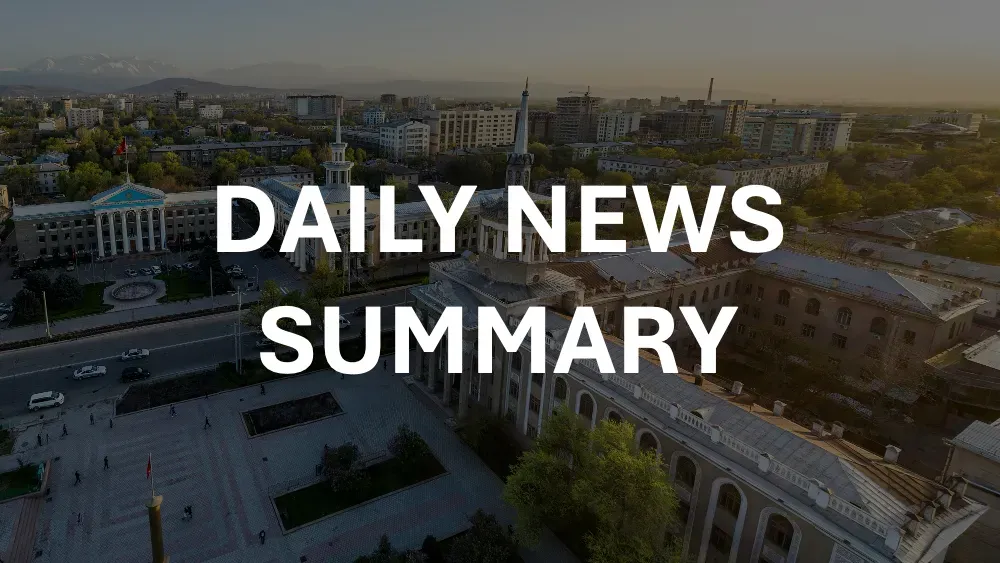📍 Get daily intelligence from Kazakhstan and Central Asia. Lexica News delivers local news that shapes global decisions—synthesized from local sources international media misses.
Kazakhstan's capital city topped the nation's 2024 Smart City rankings, demonstrating how artificial intelligence surveillance technology and digital twin implementation are reshaping Central Asia's largest urban development project. With over 100,000 video surveillance cameras connected to advanced AI-powered analytics systems, Astana represents the region's most comprehensive deployment of smart infrastructure technologies. The capital's smart city initiative operates alongside major projects including the $190 million Presight AI partnership and the ambitious $7.2 billion Alatau City development, positioning Kazakhstan at the forefront of digital governance innovation. International professionals working in Central Asia observe how these technological implementations affect urban management, public safety protocols, and business operations across the country's economic centers.
Current Landscape
Astana's smart city infrastructure currently operates 700 hardware and software systems centrally managed through the city's Control Center, integrating 6,000 cameras monitoring linear sections and intersections with 4,000 general surveillance cameras and 3,000 third-party camera systems. The Ministry of Digital Development, Innovation, and Aerospace Industry reports that alongside Astana, the cities of Almaty, Karaganda, Kostanay, and Ust-Kamenogorsk completed the nation's top five smart city implementations for 2024. These municipalities demonstrate widespread adoption of electronic fare collection systems, real-time public transport tracking, online medical registration platforms, and unified contact centers handling public inquiries through standardized 109 systems.
Kazakhstan's national approach began with the 2019 Reference Standard of Smart Cities, establishing benchmarks for technology adoption across local authorities. The framework prioritizes automation of city services, transport system optimization, energy efficiency improvements, security enhancement, and environmental monitoring capabilities. Current implementations show significant variations: while Astana leads with comprehensive AI integration, other cities focus on specific service digitization based on local capacity and infrastructure conditions.
The country's AI development strategy for 2024-2029 positions artificial intelligence as critical for economic growth and technological advancement across various sectors. Kazakhstan operates over 1.3 million video cameras nationally, with 310,000 connected to operational control centers and police duty stations. The national video monitoring system demonstrates practical results: during Astana's World Nomad Games, the technology located lost children and missing persons while helping authorities detain 46 wanted individuals in the capital and 30 in Almaty.
Smart infrastructure development extends beyond surveillance systems. Kazakhstan has introduced its first Magic Pole smart infrastructure solution in central Astana, developed through Beeline Kazakhstan and ZTE partnership. This multifunctional unit combines mobile base station capabilities with street lighting, optimizing network coverage in dense urban areas while supporting additional smart city services. The deployment represents broader infrastructure modernization affecting telecommunications, energy distribution, and urban service integration.
Documented Experiences
The Astana smart city project demonstrates measurable operational improvements across multiple urban management areas. Traffic management systems show 15-20% reduction in congestion through smart traffic light implementation, while electronic ticketing and route monitoring enhance public transport efficiency. The initiative involves deploying 14,000 general video surveillance cameras, integrating 8,000 third-party cameras, and establishing 1,202 systems for traffic violation monitoring, creating comprehensive urban oversight capabilities.
Real-world testing reveals both capabilities and limitations of AI-powered surveillance technology. The system provides face recognition, abandoned object detection, offense capture, and vehicle identification by make, model, and color. However, implementation experiences vary significantly across different urban environments and weather conditions common in Kazakhstan's continental climate. Priority deployment locations include railway stations, airports, hotels, major streets, intersections, and shopping centers, where controlled environments optimize system performance.
International partnerships shape technology deployment approaches and outcomes. The $190 million agreement with Presight AI represents a six-year commitment to develop comprehensive AI-powered smart city capabilities, involving both Emirati expertise and local implementation requirements. Kazakhstani companies handle 60% of total project scope, ensuring job creation, value retention, and technology transfer within the domestic economy. This structure demonstrates how international partnerships operate while maintaining local economic benefits.
Digital governance implementations show varied adoption rates across different municipal services. The top-performing cities have widely adopted school performance monitoring systems, electronic fare collection, real-time public transport tracking, and online outpatient clinic registration. However, citizen engagement with digital platforms varies significantly based on age demographics, digital literacy levels, and service accessibility across different neighborhoods and income levels.
Public-private partnership structures govern major smart city investments, combining international technology providers with domestic implementation capacity. The approach requires careful balance between foreign expertise, local workforce development, and technology transfer requirements. Project timelines extend across multiple years, requiring sustained political commitment and budget allocation continuity through potential administrative changes.
Stakeholder Realities
Government agencies report significant operational improvements through smart city technology integration, while businesses experience mixed outcomes depending on their sector and technology adoption readiness. The Ministry of Digital Development documents successful implementation across five major cities, yet smaller municipalities report resource and capacity constraints limiting comprehensive smart city adoption. Urban residents observe improved traffic flow and enhanced public safety measures, though concerns about privacy and surveillance oversight remain prevalent topics in public discussions.
International technology companies partnering with Kazakhstan navigate complex regulatory environments requiring local content quotas and technology transfer agreements. Presight AI's experience demonstrates how foreign firms structure operations to meet domestic value creation requirements while delivering advanced technical capabilities. The partnership model requires sustained collaboration across cultural and operational differences, with project success dependent on effective knowledge transfer and local capacity building.
Local businesses report varied impacts from smart city implementations. Companies providing technology services benefit from increased demand for digital infrastructure development, while traditional service providers must adapt to automated systems and digital payment requirements. The hospitality sector experiences enhanced security and visitor tracking capabilities, though implementation costs and staff training requirements create operational challenges for smaller establishments.
Municipal administrators document both achievements and ongoing challenges in smart city deployment. While centralized control systems improve coordination across different city services, integration complexity requires significant technical expertise and ongoing maintenance capacity. Budget allocation for technology upgrades competes with traditional infrastructure needs, creating decision-making tensions around priority setting and resource distribution.
Citizens experience direct service improvements through electronic fare collection, online medical registration, and enhanced public safety monitoring. However, digital divide issues affect service accessibility for older residents and those with limited technology access. Public consultation processes for smart city implementations vary across municipalities, with some cities demonstrating greater community engagement than others in technology deployment decisions.
International diplomatic and business communities observe how smart city implementations affect their operations in Kazakhstan. Enhanced security systems provide improved personal safety assurance, while digital governance platforms streamline various administrative processes. However, compliance requirements for technology systems and data management create additional operational considerations for foreign organizations operating in the country.
Understand Kazakhstan Like an Insider
This analysis draws from extensive research, but the story continues to evolve daily. Lexica synthesizes breaking developments from dozens of Kazakh news sources—from mining policy changes to local protests that never make international headlines.
Our daily intelligence briefs help executives, diplomats, and researchers track:
- Regulatory shifts affecting foreign investment
- Local opposition to development projects before they escalate
- Market dynamics that signal opportunity or risk
- Political developments that reshape the business landscape
Operational Context
Smart city project budgets demonstrate substantial financial commitments requiring multi-year planning and sustained political support. The national government allocated 257.5 billion digital tenge ($496 million) for digital currency circulation, while broader technology sector investments attracted over $250 million in VC funding to local startups in 2024. These figures indicate significant capital flows supporting digital transformation across both public and private sectors.
Implementation timelines reflect complex technical integration requirements and capacity building needs. The Astana smart city project operates through phases, with AI-powered surveillance deployment preceding digital twin development scheduled for completion by 2030. Project coordination involves multiple government agencies, international technology partners, and local implementation teams, requiring extensive project management capabilities and inter-organizational coordination mechanisms.
Regulatory frameworks governing smart city operations continue evolving as technologies advance and operational experience accumulates. Data protection requirements, privacy safeguards, and cybersecurity protocols require ongoing attention as surveillance capabilities expand. Administrative procedures for technology procurement, vendor selection, and performance monitoring create compliance obligations for both government agencies and private sector partners.
Technical infrastructure requirements extend beyond immediate smart city applications to supporting broader digital economy development. Kazakhstan established Central Asia's most powerful supercomputer to support national AI platform development, accessible to universities, startups, and private companies. This infrastructure investment demonstrates how smart city capabilities connect to wider technology ecosystem development across research, education, and commercial applications.
Operational costs for smart city systems include initial deployment expenses, ongoing maintenance requirements, system upgrades, and staff training needs. Municipal budgets must accommodate these technology-related expenses alongside traditional infrastructure maintenance and public service delivery requirements. Cost-benefit calculations involve quantifying improved efficiency gains against technology investment expenditures, requiring sophisticated financial analysis capabilities.
Cybersecurity considerations become increasingly critical as smart city systems expand and integrate across multiple urban functions. Protection requirements encompass surveillance data, traffic management systems, digital payment platforms, and citizen information databases. Technical expertise requirements for cybersecurity management create ongoing human resource development needs and specialized contractor relationships.
Regional Comparison
Kazakhstan's smart city development outpaces regional competitors across multiple metrics, with Astana Hub hosting 1,300 startups from 28 countries and comprehensive AI surveillance deployment exceeding neighboring Central Asian capitals. While Uzbekistan and Kyrgyzstan pursue digital governance initiatives, neither country matches Kazakhstan's scale of technology integration or international partnership structures. Tajikistan and Turkmenistan lag significantly in smart city adoption, with limited digital infrastructure development and minimal international technology collaboration.
Mongolia demonstrates comparable ambitions in digital transformation but operates at smaller scale with less comprehensive technology deployment. The country pursues smart city initiatives in Ulaanbaatar but lacks Kazakhstan's extensive surveillance infrastructure and AI integration capabilities. Economic constraints and smaller domestic market size limit Mongolia's ability to attract major international technology partnerships equivalent to Kazakhstan's agreements with companies like Presight AI.
China's western cities provide relevant comparison points for Kazakhstan's smart city development, particularly in surveillance technology deployment and urban management integration. However, Kazakhstan operates within different regulatory frameworks and international partnership structures, creating distinct implementation approaches and operational outcomes. The country's multi-vector foreign policy enables technology collaboration with multiple international partners rather than single-source dependency.
Central Asian neighbors struggle with technology infrastructure development constraints limiting smart city implementation scope. Power grid reliability, telecommunications capacity, and technical workforce availability create barriers to comprehensive smart city deployment across the region. Kazakhstan's energy sector advantages and larger economy provide resources unavailable to smaller regional economies.
Turkey and Iran represent relevant middle-income country comparisons for smart city development approaches and outcomes. Both countries pursue urban technology initiatives but operate within different geopolitical contexts affecting international technology partnerships and funding availability. Kazakhstan's energy export revenues provide fiscal resources for technology investments that other regional economies lack.
Conclusion
Kazakhstan's smart city revolution demonstrates how comprehensive technology integration reshapes urban management across surveillance, traffic control, digital governance, and citizen services. Astana's position as the nation's leading smart city reflects sustained investment in AI surveillance technology, international partnerships, and digital infrastructure development that exceeds regional competitors in scope and sophistication. The city's deployment of over 100,000 connected cameras, digital twin development timeline, and $190 million international technology partnership illustrate the scale of commitment required for comprehensive smart city transformation.
Current operational data shows measurable improvements in traffic efficiency, public safety coordination, and administrative service delivery, while implementation challenges include technical integration complexity, privacy framework development, and digital divide considerations. The requirement for 60% local content participation in major technology projects demonstrates how smart city development balances international expertise access with domestic capacity building and economic value retention. Regional comparison reveals Kazakhstan's significant advantages in technology adoption, international partnership capacity, and fiscal resources supporting digital transformation initiatives.
Monitoring developments include digital twin implementation progress, expansion of AI capabilities across additional cities, and evolution of privacy and oversight frameworks governing surveillance technology deployment. The broader context of Kazakhstan's $1 billion AI-focused VC fund, Central Asia's most powerful supercomputer, and ambitious Alatau City development indicates sustained commitment to technology-driven urban development that will influence regional smart city standards and implementation approaches across Central Asia.
Frequently Asked Questions
What specific AI surveillance capabilities does Astana currently operate?
Astana's AI surveillance system provides face recognition, abandoned object detection, offense capture, and vehicle identification by make, model, and color across over 100,000 connected cameras. The system operates through centralized control centers managing 6,000 traffic monitoring cameras, 4,000 general surveillance units, and 3,000 integrated third-party cameras. Real-time threat identification capabilities enable emergency response time improvements and enhanced overall security coordination across the city.
How do smart city technologies affect daily business operations in Astana?
Companies report direct impacts through electronic payment systems, digital administrative processes, and enhanced security environments. The implementation of smart traffic lights reducing congestion by 15-20% improves logistics efficiency and employee commute times. Electronic fare collection and real-time transport tracking affect employee mobility patterns, while online registration systems for various municipal services reduce administrative processing time for business compliance requirements.
What timeline exists for digital twin technology deployment in Astana?
The city targets digital twin completion by 2030 through a public-private partnership structure involving multiple phases of implementation. Current infrastructure deployment focuses on surveillance integration and data collection systems that will support eventual digital twin modeling. The project requires comprehensive mapping, sensor deployment, and data integration across multiple city systems before complete digital twin functionality becomes operational.
How does Kazakhstan's smart city spending compare with regional infrastructure budgets?
Kazakhstan allocated significant resources for digital transformation, with local startups attracting over $250 million in VC funding during 2024 and substantial government investment in AI development infrastructure. The $190 million Presight AI partnership represents major single-project investment exceeding most regional smart city initiatives. Broader digital infrastructure development, including Central Asia's most powerful supercomputer, demonstrates sustained financial commitment to technology advancement.
What international technology partnerships shape smart city development in Kazakhstan?
The primary partnership involves Presight AI from the UAE providing comprehensive AI-powered smart city capabilities through a six-year, $190 million agreement. Additional partnerships include Beeline Kazakhstan and ZTE for smart infrastructure solutions like the Magic Pole technology. These collaborations require 60% local content participation, ensuring domestic value creation and technology transfer while accessing international expertise and advanced technical capabilities.
How do other Kazakhstani cities compare to Astana in smart city implementation?
Almaty, Karaganda, Kostanay, and Ust-Kamenogorsk comprise the top five smart city implementations nationally, with widespread adoption of school performance monitoring, electronic fare collection, and real-time public transport tracking. However, these cities operate at smaller scale than Astana's comprehensive AI surveillance and digital twin initiatives. Municipal capacity, budget allocation, and technical infrastructure vary significantly across different cities, creating implementation differences despite standardized national frameworks.
What privacy and oversight mechanisms exist for AI surveillance systems?
Current privacy frameworks operate through existing data protection legislation and municipal oversight structures, though specific regulations for AI surveillance continue evolving as technology deployment expands. Citizens can access information about surveillance system operations through unified 109 contact centers, while data management requirements follow national cybersecurity protocols. However, comprehensive privacy legislation specifically addressing AI surveillance capabilities remains under development as operational experience accumulates and technology capabilities advance.
Track Kazakhstan with Local Intelligence
The rare earth story exemplifies why local sources matter. While international media reports MOUs and ministerial visits, Kazakh outlets cover the community protests, water disputes, and regulatory changes that actually determine project outcomes.
Lexica delivers what you're missing:
- Daily briefs at 7AM Astana time covering 40 top stories from politics to economics
- Full-text synthesis from sources in Kazakh
- Searchable archive to track how today's announcements connect to yesterday's promises
- Multi-country coverage across Central Asia for regional context
Whether you're evaluating investment opportunities, monitoring supply chain risks, or analyzing geopolitical developments, local intelligence reveals what international headlines obscure.







